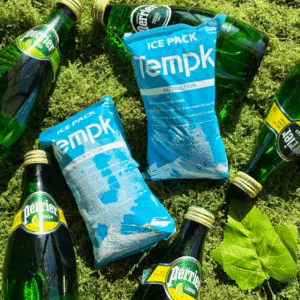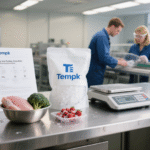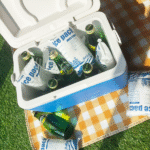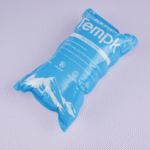Yes—will dry ice burst a sealed bag if gas cannot escape. Dry ice turns straight into CO₂ gas; à propos 1 lb produces roughly 250 litres. If you trap that gas in a sealed film, pressure climbs until the bag swells or fails. In the next 7 minutes, you’ll learn how to vent, taille, and label packaging so you stay safe, conforme, et froid.
-
The physics behind pressure: why will dry ice burst a sealed bag in common lanes
-
Venting that actually works: simple, validated ways to stop bursts in transit
-
Container choices that matter: which box designs raise or lower CO₂ risk
-
Right‑sizing dry ice: practical rules so you don’t over‑gas your shipper
-
2025 mises à jour: trends and SOP upgrades that improve safety and compliance
Why will dry ice burst a sealed bag in shipping?
Because sublimation creates far more gas than a sealed film can hold, will dry ice burst a sealed bag without a vent path. Dry ice sits at −78.5 °C and skips the liquid phase, so gas volume skyrockets. Warmer segments speed this up. A sealed zipper, heat seal, or metallized pouch traps CO₂ and turns your bag into a pressurized vessel.
De votre point de vue: you don’t need equations to see the risk. Picture two bathtubs of gas from just 1 kg. Put that behind a perfect seal inside a tight cooler and the weak point—usually the seam—gives way. The fix is humble: don’t seal it; guide the gas out. Use micro‑vents, a fold‑and‑tuck mouth, or an engineered slit. Add a vent path in the outer shipper, aussi.
How much CO₂ is enough to make a sealed bag fail?
Règle: 1 lb ≈ 250 L of CO₂ at room conditions. Surface area matters; pellets sublimate faster than blocks, so pressure ramps earlier. To keep control, design a predictable vent so the “failure mode” is intentional venting, not a random seam blowout.
| What to size | Typical figure | Pourquoi ça compte | Ce que cela signifie pour vous |
|---|---|---|---|
| Gas per 1 kg | ~250 L CO₂ | Far exceeds bag volume | Vent the inner wrap—always |
| Péllets vs. bloc | Pellets gas faster | More surface area | Prefer vented film for pellets |
| Warm segment | >20 °C for 6+ h | Accelerates sublimation | Add vents and split mass |
| Expéditeur VIP | Very low heat gain | Gas still accumulates | Vent inner + outer by design |
Practical tips that stop ruptures
-
Small packs (≤5 livres): fold‑and‑tuck with a 3–4 mm gap or 1–2 micro‑vents near the top.
-
Medium packs (5–15 lb): two micro‑vents on opposite sides, or a narrow unsealed strip.
-
Large packs (>15 kg): split into two smaller vented bags; add an outer relief vent.
-
Barrier films (Par exemple, Mylar): only use with engineered vents; never fully seal.
-
Validation: test at warm ambient for full lane duration +20% tampon; log temperature and CO₂.
Instantané réel: A pharma lane cut bag blowouts by more than half after switching from one sealed barrier pouch to two smaller, vented bags inside a lid‑notched EPS shipper. Temperature performance stayed inside band across six months of runs.
How should you package so it won’t make dry ice burst a sealed bag?
Start simple: fold, Ne sceller pas. Then make sure gas can also escape the extérieur expéditeur.
Étape par étape (operator‑ready):
-
Choose the inner: open‑mouth multi‑ply kraft for blocks; vented/micro‑perforated film for pellets.
-
Close the mouth: fold‑and‑tuck; if taping, leave a clear escape path at the fold.
-
Vent the outer: notch the foam lid, open a cooler drain, or use a filtered vent plug.
-
Right‑size ice: avoid habitual over‑icing; split mass across bags for smoother CO₂ release.
-
Mark the shipper: “Dry Ice – UN1845” and net dry‑ice weight (kg). Train teams on safe opening.
Which materials reduce the chance that dry ice will burst a sealed bag?
Vented LDPE/HDPE works when you need durability and pellet control. Kraft + light PE is forgiving and naturally breathes when folded. Metallized PET (Mylar) offers great barrier but doit include vents.
| Matériel | CO₂ behavior | When to use | Pour toi |
|---|---|---|---|
| Vented LDPE/HDPE | Controlled release | Boulettes, general lanes | Fewer seam failures |
| Kraft + PE liner | Breathable fold | Blocs, retail hand‑offs | Simple, ESG‑friendly |
| Mylar (metallized) | Traps gas | Only with engineered vents | Barrier + sécurité, if vented |
Will dry ice burst a sealed bag inside common containers?
It can—so assume yes. Better insulation slows heat but doesn’t eliminate gas. VIPs can augmenter over‑pressure risk if you forget vents because gas accumulates quietly.
-
Mousse EPS: notch a lid corner to keep a clean escape path.
-
Pur / rigid totes: use a vent plug or lid spacer.
-
VIP cartons: combine inner micro‑vents with an outer filtered vent; add a CO₂ warning label.
How much venting is “enough” so dry ice won’t burst a sealed bag?
Design for the worst segment. Plus de masse, higher temps, tighter boxes, and high‑barrier films all call for more ventilation. Use this quick self‑check to decide before pack‑out.
Burst Risk Self‑Check (1‑minute)
Répondre Oui / Non to each—two “Yes” answers means add venting or split mass.
-
Is the inner bag fully sealed with no escape path?
-
Is the film high‑barrier (Par exemple, metallized PET)?
-
Is the load ≥5 lb (2.3 kg) per bag?
-
Is the outer shipper airtight or gasketed?
-
Will it cross warm segments (>20 ° C) pour 6+ heures?
What documentation prevents “will dry ice burst a sealed bag” incidents?
Compliance is simple if you standardize.
-
Étiquettes: “Dry Ice – UN1845,” net weight (kg), Classe 9 mark for air.
-
Sops: spell out vent methods by weight tier; include photos of acceptable folds/vents.
-
Bûches: datalogger traces for temp; note any box deformation; record pack weights on each order.
-
Entraînement: gloves and eye protection; “vent before opening” placards on totes and coolers.
2025 developments and trends in dry‑ice packaging
Quoi de neuf 2025? Three fronts: smarter films, smarter boxes, and smarter planning. Will dry ice burst a sealed bag less often when you use pressure‑responsive micro‑vents that open at low PSI and re‑close at rest. Outer shippers now ship with integrated vent plugs and gas‑diffusion channels. Teams are adopting digital lane modeling to match ice mass and venting to the hour, cutting failures and material waste.
The latest at a glance
-
Évents intelligents: films that open under low pressure to avoid seam pops.
-
Vented lids: molded channels and filtered plugs keep insulation but let CO₂ out.
-
Lane modeling: quick tools that right‑size ice and venting by route time and ambient map.
Perspicacité du marché: Growth in biologics, kits de repas, and cross‑border frozen foods favors designs that balance performance and safety. Vent‑aware SOPs reduce rejections, improve audit scores, and lower damage credits.
FAQ
Q1: Will dry ice burst a sealed bag?
Oui. Gas expansion in an airtight film drives pressure up until the bag swells or fails. Use a fold‑and‑tuck closure or engineered micro‑vents.
Q2: Do coolers prevent failures?
Non. A sealed inner bag can still burst inside a cooler. Vent both the inner wrap and the outer shipper.
Q3: Can I just poke one hole?
Often for ≤5 lb, one 2–3 mm hole near the fold works—but validate at warm ambient. Larger loads need distributed venting or an unsealed strip.
Q4: Are Mylar pouches safe?
Only if vented. Metallized films are excellent barriers and ne doit pas be fully sealed around dry ice.
Q5: Quelle quantité de glace carbonique par 24 heures?
Depends on shipper and route. Many lanes land near 5–10 lb per 24 h—model your lane and avoid habitual over‑icing.
Résumé & recommandations
Points clés: Will dry ice burst a sealed bag if you trap CO₂. Prevent that with a vented inner wrap, a relief path in the outer shipper, and right‑sized ice. Split large masses across smaller vented bags. Validate at warm ambient with a small time buffer and document your SOPs.
Que faire ensuite: Standardize two venting patterns by weight tier; add a lid notch or vent plug to your shipper; and add a simple “package vented?” check to your pack‑line QA. CTA: Need a lane‑specific SOP with photos and acceptance wording? Talk to our packaging engineers.
À propos du tempk
We design cold‑chain packaging that balances safety, performance, et durabilité. Our portfolio includes vented dry‑ice bags, hybrid Mylar‑Kraft solutions, and CO₂‑relief shippers validated for pharma, biotechnologie, and frozen food logistics. With lane modeling and QA playbooks, we help you ship colder, plus sûr, and smarter.
Prochaine étape: Request a free “vented pack‑out” template tailored to your shipper size, route time, and dry‑ice format.
























